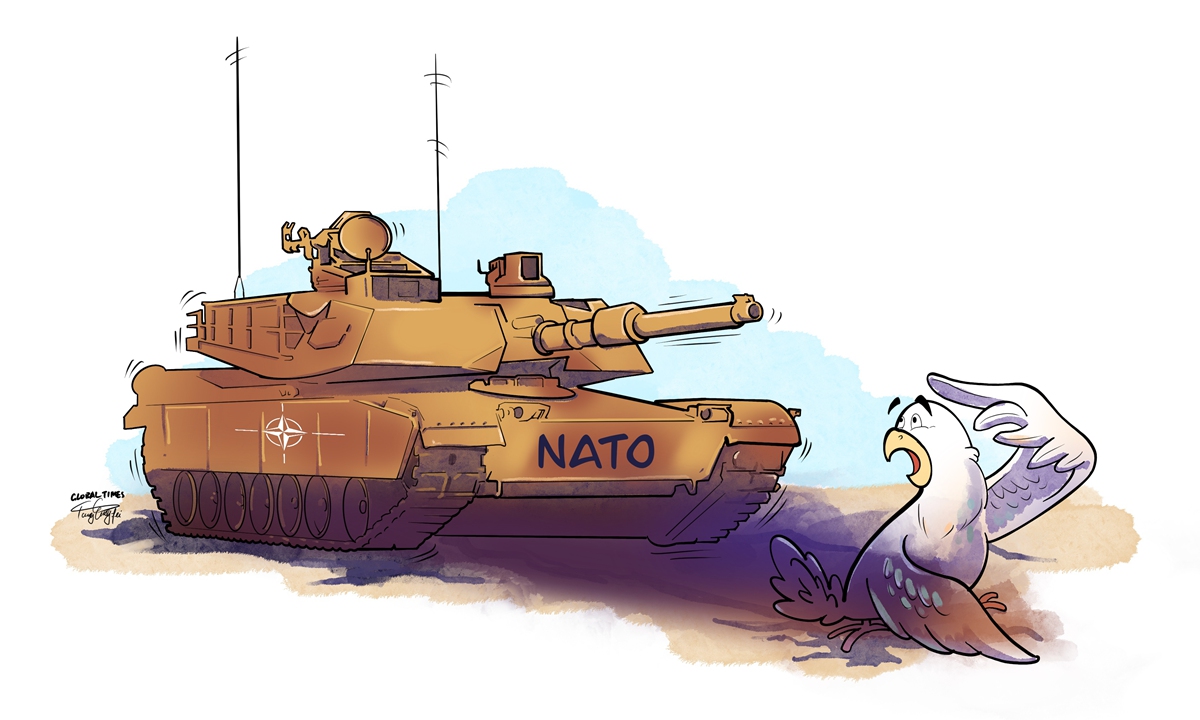
Illustration: Tang Tengfei/GT
It would be misleading to call NATO's ongoing exercise simply a war game because that evokes scenes of people in costume reenacting historic battles or modern armies charging about, field-testing their tactics and equipment. Exercise Steadfast Defender 2024 is far from harmless. It is very much a rehearsal, and - in a theater where war is already raging - possibly even a provocation. With the Russia-Ukraine conflict still ongoing, Steadfast Defender - NATO's largest military venture since the Cold War - could be seen by Moscow as a deliberate poking of the Russian bear.
As the bloc's 31 armies, along with another from membership contender Sweden, hurl 90,000 of their military personnel into a make-believe battle, Russia and Ukraine's forces are engaged in a very real and deadly conflict on NATO's doorstep. It is crucial for NATO to consider the risks of miscalculation and the resulting escalation to ensure that their simulated exercises do not inadvertently become entangled with the actual theatre of war next door, which would be too terrifying to think about.
Let's not forget that while NATO is engaged in military exercises from Europe's High North to Central and Eastern Europe until May 31, it is simultaneously deeply involved in the conflict with Russia through its proxy, Ukraine. Furthermore, the alliance's own statements claim the drills are specifically to test its ability to "deploy forces rapidly from North America and other parts of the alliance to reinforce the defense of Europe." In other words, the large-scale participation of 32 armies is a preparation for the potential scenario where proxy engagement escalates into open warfare with Russia.
It is a day that Western politicians and senior armed forces personnel increasingly seem to expect. In January, Britain's defense secretary Grant Shapps ominously predicted that the UK could be at war with Russia, China, North Korea and Iran within five years. Then Britain's top soldier, General Sir Patrick Sanders, chief of the General Staff, made a rallying cry last year, urging his troops to prepare to defeat Russia "in battle."
The chair of NATO's military committee, Dutch admiral Rob Bauer, said large numbers of civilians will need to be mobilized for a Russia conflict.
Sweden's Military Commander-in-chief General Micael Byden stated that all Swedes should be mentally prepared for war. Germany's Defense Minister Boris Pistorius said war with Russia could be possible in the next five to eight years. General Eirik Kristofferson, the head of Norway's armed forces, warned: "The people of Norway should give thought to their readiness. We recommend being able to cope without outside help for three days." Estonian Prime Minister Kaja Kallas has cautioned that Europe has three to five years to prepare for any threat from Russia. All suggest that civilians will be central to any future war. The populations are being groomed. They are being told NATO is a defensive shield, when increasingly it looks like a brandished sword.
Talk of "three to five years" is significant, as that is the time it will take NATO's nations to restore their equipment and ordnance stockpiles, after supplying so much to Ukraine.
The NATO countries are so deeply enmeshed in the Russia-Ukraine fighting that they have effectively become Kiev's quartermaster. It is a role they have played with increasing enthusiasm - and increasing lethality. When the conflict began almost two years ago, there were diplomatic protests, many nations threw open their borders to refugees, but James Heappey, the UK's minister for the armed forces, told the House of Commons: "British and NATO troops should not - must not - play an active role in Ukraine."
Yet two years on, we are much closer to realizing what he said should never happen, with NATO's generals and Europe's politicians openly talking of war with Russia and prepping their populations for the worst.
Britain escalated its initial token military support of anti-tank missiles and modest kit like rations to include many thousands of missiles, air defense systems, and £25 million to pay armed forces' salaries. Mission creep eventually saw more than 120 armored vehicles, anti-ship missile systems, and £1.3 billion of financial aid followed. Short and medium-range missiles soon became long-range missiles.
Then there were strike-capable and naval drones. Long-range artillery, cruise missiles, helicopters, a squadron of 14 Challenger 2 main battle tanks, and even ships were dispatched. When, with the US' blessing, the Netherlands and Denmark supplied F-16 fighter jets.
Crucially, the West's war aims have also changed: the Tallinn Pledge committed some to not only defend Ukraine but also to remove the Russians from disputed territory. If they continue down this path, could this pledge, along with the Article 5 commitments of the recently-expanded NATO - with Finland now part of the family and Sweden awaiting only Hungary's approval - unleash the dogs of war?
Under cover of the ongoing exercises, with officials and politicians talking almost casually about World War III, NATO is not merely playing at war but preparing for it, and perhaps, it could even provoke it. Exercise Steadfast Defender marks the point at which NATO transitions from the pretense of a defensive union into a warlike one. Is the world on the brink of no return? Is it a matter of "when" rather than "if"?
The author is a journalist and lecturer in Britain.
opinion@globaltimes.com.cn




